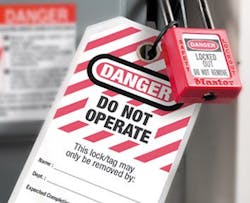Designed to guard against injuries and deaths that can occur when someone is working on equipment while someone else inadvertently turns it back on, OSHA’s lockout/tagout safety regulations are a critical procedure for all automated operations.
The lockout/tagout regulation (29 CFR 1910.147) focuses on disabling a machine by isolating it from its source of power. Lockout refers to shutting off the energy source to the piece of equipment being worked on; tagout refers to posting a notice on the equipment’s power source as to what type of work is being done on the machine.
According to OSHA, the common sense lockout/tagout procedures should be followed whenever repairing a machine’s circuits, cleaning/oiling machinery, clearing jammed mechanisms, rebuilding equipment, or performing machine set-up.
Compliance and Safety Training is offering a free download of its lockout /tagout safety training Powerpoint. The presentation covers:
• The scope, application and purpose of the lockout/tagout program;
• Definition of terms;
• Explanation of the Energy Control Program and related procedure;
• What materials and hardware are involved;
• How to conduct periodic inspections; and
• Proper training and communication.
Sponsored Recommendations
Leaders relevant to this article:

